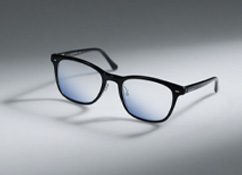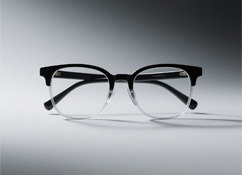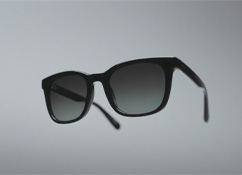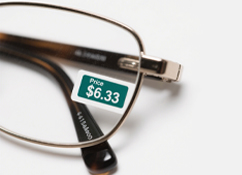8 Common Myths About Nearsightedness Glasses
Myth 1: No Need for Glasses if Myopia Isn’t Severe
In general, if your nearsightedness is less than 75 degrees after a dilated eye exam and doesn’t affect daily life, work, or study, you may not need glasses.
However, if your nearsightedness exceeds 100 degrees, you should get glasses to correct it promptly. For cases where myopia significantly impacts daily life—such as high myopia, rapidly worsening myopia, high astigmatism, a 300-degree difference in nearsightedness between the two eyes (called anisometropia), or related eye conditions (like strabismus, amblyopia, or nystagmus)—you should wear glasses long-term or use other professional treatments.
Myth 2: Glasses Should Be Slightly Weaker Than Needed
The key rule for prescribing myopia glasses is: use the lowest lens power needed to achieve the best vision correction. When you put on well-fitted glasses, you should see clearly, feel comfortable, and have no double vision, eye strain, or dizziness.
Wearing glasses that are too weak (under-corrected) or too strong (over-corrected) for a long time can disrupt the balance between eye focus and eye alignment, which may actually make myopia worse.
So, the right lens power and any necessary adjustments should be determined by a professional eye doctor after an exam. If new lenses cause issues like distorted vision, eye soreness, dizziness, or trouble judging distances/sizes, it may be due to over-correction, wrong astigmatism axis, or ignoring binocular balance. If these problems persist, adjust the power, pupil distance, or lens optical center to help your eyes adapt.
Myth 3: No Need to Wear Glasses When Not Looking Far
In daily life, some people use different glasses for different situations.
If you have 300–600 degrees of myopia and your eye alignment and focusing functions are normal, you might consider two pairs of glasses: one for seeing far (with full correction to ensure clarity) and one for seeing close (with a slightly lower power than the far pair, adjusted based on age and eye focus ability). This way, you get clear distance vision and avoid eye strain when looking at close objects.
But if you only have one pair of glasses, don’t take them off and on frequently. Not wearing glasses when looking close (but wearing them for far vision) can weaken your eyes’ focusing ability and speed up myopia progression.
Myth 4: Long-Term Glass Wear Causes Bulging Eyes
People with high myopia often have bulging eyes, but many think this is from wearing glasses.
In fact, bulging eyes are a result of the eye’s natural structure in high myopia, not from wearing glasses. The main difference between a nearsighted eye and a normal eye is that the nearsighted eye is longer (longer eyeball length). The higher the myopia, the longer the eyeball. Roughly, every 1mm increase in eyeball length adds about 200–300 degrees of myopia.
Myth 5: Only Myopia Degree Matters for Glasses
There are many ways to get glasses these days, including online stores that make them using your data. But many people only provide their myopia degree when ordering online. A proper prescription needs more details: spherical power, cylindrical power, spherical-cylindrical power, axis, and pupillary distance (PD).
· Spherical lenses correct simple farsightedness (positive numbers) or nearsightedness (negative numbers).
· Cylindrical or spherical-cylindrical lenses correct astigmatism (positive for farsighted astigmatism, negative for nearsighted astigmatism).
· Axis refers to the angle where astigmatism occurs.
· PD is the distance between the centers of the two pupils. For far vision, PD is usually 2mm longer than for close vision, because eyes focus inward when looking at near objects.
To get well-fitted glasses, you need accurate parameters, plus considerations like lens-to-eye distance, frame details, and how the frame fits your face. So, it’s better to get an exam at an in-person professional clinic. Online glasses are convenient but have limitations. Also, get your vision checked yearly. If myopia increases by more than 50 degrees, adjust your habits, rule out eye diseases, and consider new glasses.
Myth 6: Wearing Glasses Makes Myopia Worse
Some worry that once you start wearing glasses, you can never stop—and that long-term wear makes myopia worse. The opposite is true: getting glasses from a professional clinic, using your eyes properly, and regular check-ups help control myopia. On the other hand, not correcting vision promptly, along with bad habits (like too much screen time), will make myopia worse.
Myth 7: Myopia Stops Changing in Adulthood
Adults’ vision is more stable than children’s or teens’, but that doesn’t mean myopia never gets worse. Long hours of close work—like using computers/phones, watching TV, reading, drawing, or reading sheet music—keeps eye muscles tense. Lack of outdoor time also raises the risk of worsening myopia in adults, which is common in clinics. In rare cases, like pathological myopia, myopia can get worse even in adulthood.
Myth 8: Surgery Can Reverse Myopia
So far, no method can reverse myopia. All current treatments only slow its start and progression. Myopia surgery just fixes the refractive error (how the eye bends light), but it can’t undo eye tissue changes caused by myopia, nor reduce the risk of related eye problems. So, both kids/teens and adults should take good care of their eyes.
Tip
What’s the “red-green light” on the eye chart for? Red and green light have different wavelengths, so their focus points on the retina are slightly different. During an exam, the doctor uses how clear these red and green marks look to adjust lens power. When both look equally clear, the lens power is just right.











